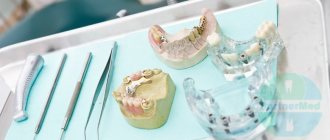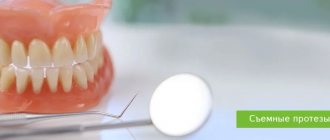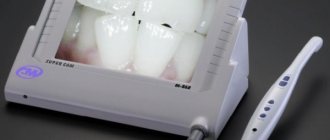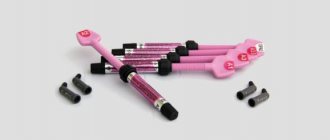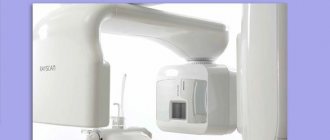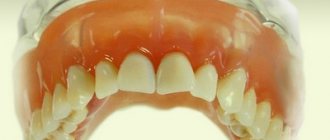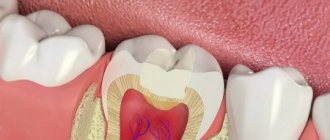Today, plastic surgery uses two main types of endoprostheses:
- silicone implants;
- saline.
There are also bioimplants, the so-called “blue” ones. Their filler is carbomethylcellulose, a natural polymer. If such an endoprosthesis leaks, then when it enters the tissue, the filler substance will decompose into carbon dioxide, water and glucose. They are considered the safest, but do not inspire confidence among surgeons due to their low reliability.
Silicone endoprostheses differ in a number of ways.
By profile
The profile is the boundaries beyond which the implant can extend while in the mammary gland.
- Low – the implant is smaller compared to the breast. Such products are installed on women with small breasts and normal chest parameters.
- Medium – equal in volume to the diameter of the gland. Medium-profile endoprostheses are installed in women with medium-sized breasts.
- Tall – the product is larger than the diameter of the chest. Suitable for patients with severe ptosis of the bust, as well as with a narrow chest.
By surface type
- Smooth . They reduce the risk of wrinkles, but their shell is thin, which increases the likelihood of tearing.
- Textured . Their shell is thicker, so the risk of rupture is reduced. However, surface roughness reduces the freedom of the endoprosthesis in the gland bed and increases the likelihood of folds forming.
By shape
- Round . Their advantage is that they do not change the shape of the bust if they are rotated. However, sometimes the upper area of the mammary glands is made round, which is unaesthetic.
- Drop-shaped (anatomical) . They look better, but if the endoprosthesis is rotated, the breasts become unnatural. Always have a rough texture.
At the site of installation (in relation to the pectoralis major muscle)
- Subfascial
. Placed between the bust tissue and the pectoral muscle, but under its fascia. This improves fixation, according to some plastic surgeons. - Subglandular
. They are installed between the breast tissue and the pectoralis major muscle. The aesthetic result in this case is the best. However, this installation method is not recommended for women with large breasts and thin soft tissue in this area. - Axillary
. The method of installing such silicone implants is under the pectoral muscle, which is not cut. - Subpectoral
. They are placed partly under the mammary gland and partly under the pectoral muscle, which is dissected at the bottom.
The shape, size, and method of installing the implant are determined during the consultation.
By density of filler (gel)
There are:
- soft (does not hold its shape very well, the density is the same as the bust);
- dense (no risk of deformation, but the shape is unnatural);
- soft touch (medium density, holds its shape relatively well).
Benefits of using Implanon
Implanon is rightfully considered one of the most reliable hormonal contraceptives - it protects against unplanned pregnancy in 99.9% of cases.
In addition, its main advantages include:
- Lack of estrogen. Implanon contains only progestogen, which means it is suitable for women who are contraindicated in taking estrogen and those who do not want to take it for personal reasons.
- After installation, the subcutaneous implant is not noticeable to others (therefore, other specialists must be warned about the procedure themselves). It can only be detected by palpating the skin at the injection site.
- The contraceptive can be removed at any time at the request of the woman. Moreover, within one monthly cycle after extraction, ovulation is completely restored.
Another compelling argument in favor of installing an implant is the cost of the procedure. Its use is cheaper than taking more than 1 thousand tablets for 3 years, for which you need to spend an average of 30 thousand rubles.
Implanon: implant installation
To install Implanon, you must consult a doctor, since this process is a minor surgical operation. Implanon is installed on the inner surface of the shoulder of the arm that is less involved in a woman’s daily life (for a right-handed person, the implant is installed in the left arm, for a left-handed person, vice versa).
Before installing Implanon, the surgical field is treated with antiseptics, the doctor makes a mark at the place where Implanon will be administered. After this, local anesthesia is performed, the doctor makes a miniature incision and inserts the implant. The incision is fixed with one suture, which is removed after 7–10 days.
Procedure for introducing and removing Implanon
Important! Before installing the implant, it is necessary to exclude possible pregnancy.
The contraceptive is administered between days 1 and 5 of the menstrual cycle. Only one hormonal implant is allowed. You can remove it at any time, but no later than 3 years after installation.
The procedure must be carried out by a qualified specialist familiar with this method of preventing unwanted pregnancy. To avoid discomfort, local anesthetics are used when introducing or removing Implanon. If, after the expiration date, one contraceptive implant is immediately replaced with a new one, contraceptive protection is maintained.
Important information about contraceptive implants:
- the effectiveness of contraceptive implants reaches 99%;
- implants have a long validity period - from three to five years;
- after removing the contraceptive implant, the reproductive functions of the woman’s body are restored almost immediately;
- After installation of the implant, changes in the menstrual cycle may occur. Menstruation may become irregular, less or more heavy. Some women experience amenorrhea for several months;
- some medications can reduce the effectiveness of the implant, so if you are taking any medications, be sure to tell your doctor about it;
- A contraceptive implant cannot protect against sexually transmitted diseases.
Who can get a contraceptive implant?
This product is recommended for use by women of any age, from the beginning of sexual activity to the onset of menopause. The hormone contained in Implanon passes into breast milk in a minimal amount, so its use is safe during lactation. The contraceptive does not affect the quality and quantity of breast milk.
Under medical supervision, the use of hormonal contraceptives is possible for diabetes mellitus and systemic lupus erythematosus. It can also be part of therapy for some dishormonal gynecological diseases, for example, endometriosis and dysmenorrhea.
Can the menstrual cycle be disrupted after using an implant?
Changes in period patterns are common and usually unpredictable. Menstruation may be virtually absent, become rarer, more frequent, or even constant. The amount or duration of discharge may also change. By how the pattern of bleeding changes in the first 3 months, one can judge their further nature.
It is important that the subdermal implant is installed by a specialist. By contacting Es Clinic MC, you are placing yourself and your health in the hands of real experienced professionals.
Contraindications
The use of subcutaneous contraceptive is not recommended in case of hypersensitivity to individual components of the drug. Contraindications also include:
- migraine;
- thrombosis, thromboembolism;
- previous heart attack;
- cerebrovascular accidents, stroke;
- malignant neoplasms of the mammary glands and other tumors of the reproductive system;
- liver dysfunction, benign or malignant neoplasms of the organ;
- severe form of arterial hypertension;
- vaginal bleeding of unknown etiology.
Implanon is also contraindicated in case of a positive test for antibodies to phospholipids.
How are silicone implants used in plastic?
Plastic surgeons at SM-Clinic also work with French SEBBIN implants. Their production uses exclusively manual labor; implants can be made to order. There are no companies in the whole world that produce such a wide range of products in terms of size, shell texture, and filling. The company also provides a lifetime guarantee against breaks! The scope of application of silicone endoprostheses in plastic surgery is wide; we will consider ways to correct the body and face with their help.
- Bust reconstruction after mastectomy. In case of oncology, the breast is removed completely or partially. Installation of an endoprosthesis can be done simultaneously (during surgery to remove a cancerous tumor) or delayed (correction some time after a radical mastectomy).
- Mastopexy (breast lift)
. Endoprostheses are implanted when a woman wants to change not only the shape of her bust, but also its size. - Endoscopic breast augmentation
. This technology is needed when an incision is made in the armpit area, because in this case the implant can only be installed using optical instruments. The endoscope provides the surgeon with visual control over the manipulations. - Gluteoplasty – correction of the volume and shape of the buttocks. Special implants are used that will withstand a specific load - long sitting, running, sports. They have a dense shell and silicone filler. There is no need to change them over time.
- Curoplasty is a change in the shape of the calf area. Endoprostheses allow you to correct false curvature of the legs and replenish volume if the muscle layer is thin or hypotrophied.
- Facial contour correction, rejuvenation
. For this purpose, implants are produced in different sizes and shapes, they allow you to adjust the proportions of the face. They are used to highlight cheekbones, enlarge the chin and jaws, and smooth out areas under the eye sockets. Surgeons use facial prostheses made of hard silicone rubber. Typically, products with a thickness of 4 mm are installed, for a more expressive result - 5-6 mm. The product can also be made to order according to individual parameters.
Breast reconstruction: the story of one victory
What does a woman experience who has survived breast cancer, amputation, long and difficult treatment, and emerged victorious from this situation? Only she knows this, but the fact that a mastectomy is not a reason to put an end to future life is beyond doubt. And a real case from practice will help you verify this.
The patient was diagnosed with stage 3 breast cancer at the age of 38. One day, in the shower, she simply felt a lump in her chest, turned to a therapist, and he advised her to go to an oncology clinic and undergo an examination.
Several tumor foci were identified. Then there was a long and tedious treatment, 6 months of chemotherapy and a radical mastectomy. Since the disease was diagnosed at a late stage, a large amount of tissue had to be removed and the mammary gland had to be completely removed. But we managed to save all the skin and nipple.
Thanks to this, during reconstructive surgery there was no need to stretch the skin and install temporary expanders. We were able to immediately proceed to installing the implant, avoiding additional surgical intervention.
An anatomical implant was chosen for the operation because it closely matches the shape of the natural breast.
An incision was made in the area of the submammary fold and an implant was installed. The reconstructed breast turned out to be larger in volume than the healthy one, so it was decided to perform a symmetrizing operation. An endoprosthesis was installed in the second breast and the skin was tightened.
How justified is breast reconstruction after mastectomy?
Oncological disease and concomitant therapy is in itself a serious test for the body. And the joy of recovery is often overshadowed by disfigured breasts, loss of femininity and physical attractiveness, because one of the main ways to stop the spread of a malignant tumor was and remains a mastectomy.
It is no coincidence that many women begin their return to normal life and its joys with breast reconstruction. Reconstructive plastic surgery can be one-stage – it is performed simultaneously with the removal of the mammary gland in one operation. Or delayed - some time after the amputation.
Reconstructive surgery, if performed by an experienced reconstructive surgeon, is absolutely safe and, what is especially important and proven by many years of research, does not increase the risk of tumor recurrence.
Mastectomy is performed not only for oncology, but also in a number of other cases:
- breast sarcoma;
- purulent inflammation, mastitis, abscess formation;
- severe trauma to the mammary gland;
- gynecomastia;
- prevention of diseases with a genetic predisposition to them.
In all these cases, it is possible to restore the removed mammary glands.
In what cases is it impossible to install breast implants after a mastectomy?
Breast reconstruction is suitable for most patients; it can be performed in any clinical cases, with the exception of a number of contraindications:
- recurrence or progression of cancer;
- disturbances in the functioning of the immune system;
- severe heart or vascular disease;
- bleeding disorders;
- hepatitis and other liver diseases;
- the presence of infectious diseases - in this case, the operation is simply postponed until recovery;
- poor physical condition of the patient.
Contraindications are identified at the examination stage.
Moreover, if the patient is undergoing radiotherapy, radiation or hormonal therapy, it is recommended to undergo surgery, since these treatment methods negatively affect the condition of the skin and soft tissues and can cause complications.
For this reason, implantation should be carried out before or after a course of therapy, but not in parallel with it.
Fillers - pros and cons
You can correct the shape of your face by using special filler substances called fillers. The main advantage of this method of correcting aesthetic defects is its minimal invasiveness. They are injected into the skin and effectively smooth out wrinkles and folds, correct the shape of the face and restore volumes that have been lost with age.
In most cases, fillers are composed of hyaluronic acid. This substance is not rejected by the body, as it is originally contained in human skin. Injections of hyaluronic acid can solve a number of aesthetic problems, namely:
- irregular chin shape;
- thin lips and their unclear outline;
- insufficient fullness of the cheekbones;
- pronounced nasolabial folds;
- creases between the eyebrows;
- sunken cheeks;
- horizontal wrinkles on the forehead;
- lip asymmetry;
- expression lines around the eyes and mouth;
- acne marks.
Hyaluronic acid gives your skin a fresher, more youthful appearance. Due to the binding of water molecules and neutralization of free radicals, the skin becomes hydrated and looks much better. The administration of the drug increases the access of oxygen to cells and stimulates the production of elastin and collagen. Thanks to this, the face is lifted, even deep wrinkles and folds are smoothed out, and the skin texture is evened out.
Advantages and disadvantages of installing implants
The main advantages of this procedure include the ability to effectively eliminate asymmetry of the face shape and get rid of a number of aesthetic defects. In addition, implants allow you to get a permanent result that does not need correction. Moreover, the procedure is quick and minimally invasive - there is no need to transplant fat tissue taken from other parts of the body.
But implantation also has its disadvantages. If the implant is installed incorrectly or is allowed to shift, the contours of the face will be disrupted. In addition, it is possible to develop such serious postoperative complications as infection of the wound surface or damage to the facial muscles and nerves. However, it is possible to avoid these complications by entrusting the operation to first-class specialists.
Long-acting contraceptives
- Injectable
- pure progestins – Depo Provera
- combined – Lunelle
- Subcutaneous implants – Norplant, Implanon
- Transdermal patches – Evra
- Vaginal rings
- Intrauterine devices (copper-, gold- and hormone-containing)
Advantages
- Highly efficient
- Long-term contraception
- The effectiveness of the method does not depend on the user
- Confidentiality
- Positive non-contraceptive effects
Flaws
- The need for medical personnel to administer and remove the drug
- Inability to quickly discontinue the drug
- Delayed return of fertility
How are implants installed?
The patient will first need to undergo a health examination to ensure there are no contraindications. Installation of implants involves the use of local intravenous or general anesthesia. On average, the duration of surgical intervention does not exceed 30-45 minutes.
Initially, the surgeon makes incisions inside the mouth. This approach to their installation allows you to avoid the formation of scars on the skin. If implants are placed in the chin, the incision line runs between the lower lip and the fold of the gum. Less commonly, surgical access is obtained by making an incision under the jawline.
After the necessary cuts have been made, a so-called pocket is formed. This is where the implant is installed. Next, sutures are placed using self-absorbable threads.

